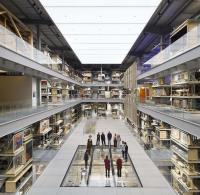Xiaoquan Elementary School
Deyang, China
The old Xiaoquan Elementary School was severely damaged during the catastrophic 5.12 Sichuan earthquake in 2008 and was demolished afterwards. Supported by donations from several sponsors, the project is to build new school in the center of Xiaoquan old town. The program consists of main classroom buildings, classrooms for various activities, teacher’s office, student dormitory buildings, and dining hall. The new school will host more than 900 students.
The main idea is to conceive a school as a small city, giving diversified space so as to enrich children's experience and activity. The design is conceived as a cluster of small buildings to create a micro-city like campus. The fragmentary instead of unified building composition defines many typological places such us streets, plazas, courtyards, and steps, analogous to original Xiaoquan's urban space in scale and pattern, so as to provoke a familiar feeling from daily life. These places are intended to encourage diversified and spontaneous activities of children. Various-scale playful corners and labyrinth spaces as passages and playgrounds are created to provoke children’s curiosity and imagination. Through this, we also intend to continue the urban space memory of Xiaoquan town, so as to avoid a rebuilding in brutal, overwritten style without respecting past, which is typical in earthquake area.
The design responds to Sichuan's hot and humid climate. Sunshade device, natural ventilation and heat reduction are important elements considered in design. Unlike many rebuilding projects in Sichuan, whose materials and workers was completely imported from other province as a state-organized action, we explore to maximize the use of local resources which can be acquired, including material and technique, so that local workers can get involved. Local materials such as wood, brick and bamboo are used for windows, walls, and ceilings. The recycled bricks from earthquake are used in pavement. Cast-in-situ concrete are used for exposed structure. The construction is completely done by a local contractor. The construction cost is well controlled within the economical budget of RMB 1,500 yuan per square meter.














